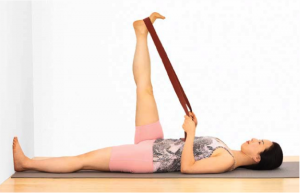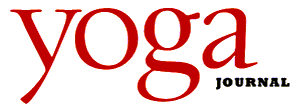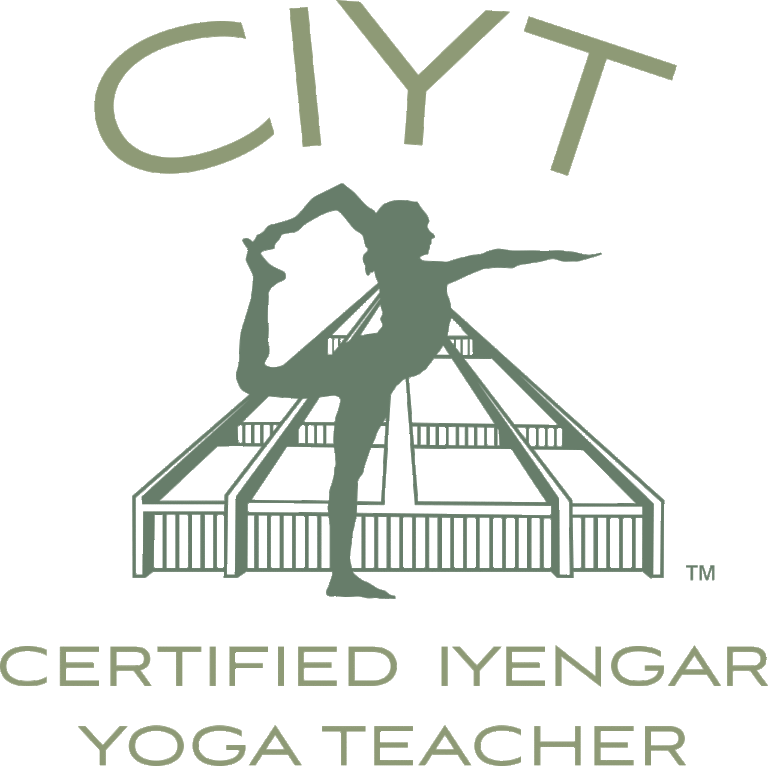Originally published in Yoga Journal Magazine, this article has been translated into Spanish and published in Om Yoga Venezuela Magazine, available online on page 31.
Supta Padangusthasana is my go-to pose for lower back pain. In this asana the back muscles and hamstrings are safely stretched while the back is supported by the floor, preventing it from rounding or pushing backwards. The correct actions in the pose help create traction in the lower back while the asymmetrical nature of the stretch can balance tension and distortion on the two sides of the back.
Even though you can’t see it, don’t neglect the bottom leg in this pose. Although it seems like all of the action occurs in the top leg, the real life and benefits of the pose come from the proper extension of the leg on the floor and the interplay between the two legs. According to yoga philosophy, our consciousness is comprised of three components: ego, mind and intelligence. Normally, our ego, which identifies with what moves, what is seen and what is known predominates. However, as BKS Iyengar says “the practice of asana is meant to bring the unknown into the sphere of the known,”1 balancing the components of consciousness in the process. In Supta Padangusthasana you have the opportunity to cultivate intelligence and let your ego take a back seat. The top leg in this pose is visible and the ego associates with its movement while the leg on the floor is out of sight and out of mind. By spreading your awareness to the actions of the bottom leg, you will allow the intelligence to play an active role in the pose. Intelligence cultivates discrimination; it is the ability to make connections grounded in a comprehensive understanding of the whole. While the ego may be gratified by bringing the foot close to your head or catching hold of the big toe with your hand, instead let the intelligence in your bottom leg be your guide as to how far to extend in the pose. The result is not just a safer and more beneficial pose for your legs, hips and back but your mind will have the opportunity to spread throughout the entire system bringing you towards a union of body and mind.
Tight hamstrings should not deter you from practicing this wonderful asana and using the belt in the first variation makes it accessible for all. The second variation stretches the inner thigh adductor muscles and can be very helpful for setting an uneven sacrum as well provide relief for those in the throws of sciatica pain. Both variations help to teach the interaction between the legs, hips and lower back, principles that can be translated into your practice of standing, seated forward bending, and inverted asanas.
Lie down on your back with your heels on the floor, soles of your feet against a wall. Bend your knees slightly and place your palms under your sacrum. Slide your sacrum and buttocks towards the wall with your hands as if smoothing out and lengthening your lower back. Then push your heels into the wall and straighten your legs without losing the adjustment you just gave yourself. This adjustment gives an important sense of direction for you throughout the pose so feel free to repeat it if you have lost the sensation of the lengthening of the sides of your lower back towards the wall.
Press both thighs down into the floor. See if you can get the backs of your thighs to touch the floor. Extend your calves towards your heels as you press the inner edges of your heels into the wall.
Bend your right knee towards your chest and place the belt around the balls of the toes. Separate the sides of the belt and hold them with both hands. Without disturbing your left leg on the floor, stretch your right leg straight towards the ceiling. Start with your right leg further away from your head than a 90-degree angle from the floor, closer to a 60 degree angle. It should be easy to straighten both legs here, if not, slide your hands down the belt and move the right foot even closer to the wall.
Press the front of your left thigh straight down into the floor. Turn the left thigh inwards so that the inner thigh and knee remain grounded. If you feel that the front of the left thigh is popping up, take your right foot further away from your head. Extend from the inner left thigh into the inner left heel into the wall. Intelligence is connected to the sense of touch in the skin so see if you can maintain the sensitivity to the stretch in the left inner leg as you start to bring the right leg higher up toward the ceiling, closer to a 90 degree angle. Don’t allow your ego’s impulse to bring your foot close to your head to overpower your intelligence in the left leg.
If you aren’t able to completely straighten both legs or if in the process of lifting your right leg higher your right buttock rises from the floor, slide your hands down the belt and take your right foot further away from your head.
Extend from your calves towards your heels. Observe the right buttock. Does it still feel long on the floor like after you adjusted it with your hands? If not, move the right outer hip away from your head towards the wall to lengthen the right side of your back and waist on the floor. Pull the right thigh bone down into the hip to ground the right hip socket into the floor.
Now you can start to bend your elbows and see whether or not you can bring your right foot closer to your head. Go slowly so that you don’t lose the extension of your left inner leg and the length on the right side of the waist. The more your right foot comes towards your head, the more you have to press your left thigh down, inner left heel into the wall and the right hip down into the floor and away from your head. Let all of these actions be your guide to help you determine how high to take the right leg. Rather than focusing on bringing your right leg to a particular angle from the torso, spread your awareness throughout all aspects of the pose while stretching the right leg.
Hold for up to one minute and then bend your right knee and release your right leg down to the floor. Stretch both feet into the wall again before changing sides.
Place a block on the floor one arm’s distance from your torso on your right side. Begin as in the previous variation adjusting the sacrum with both hands and extending both legs straight on the floor before placing the belt around the right foot. Now hold both sides of the belt with your right hand. Press your left thigh strongly into the floor and heel into the wall and keeping both legs straight take your right leg out to the right side, in line with your hip. Pause for a moment when your right leg is halfway down and again charge your left heel into the wall, keeping your left hip on the floor so that you don’t topple to the right side. Extend from your inner right thigh to your inner right heel and move your outer right hip and buttock away from your head towards the wall, as you had adjusted with your hands earlier. Keeping the legs straight and the left side grounded, lower the right leg further to the right and pull the foot slightly away from the wall to place the outside edge of your right foot on a block. If the block is not tall enough or if your left hip lifts off of the floor in order to reach the block, add a block or blanket or two or alternatively use the seat of a chair as a support. As in the previous variation, let the intelligence in your left leg be your guide as to how far you can move the right leg and foot to the floor. In addition to keeping the left hip down, the left inner leg should remain extended towards the inner heel into the wall while the thighbone presses straight down into the floor. Extend both inner legs away from the pelvis, away from each other.
Relax your face and throat and take a few smooth exhalations. Look upwards keeping your head, chest, and abdomen centered. On the inhalation, bring your right leg back up into the first variation, bend your right knee and place the leg on the floor to repeat on the left side.
Variation #3
Now come away from the wall. Lie down on your back, adjust the buttocks with your hands as you did in the previous variations and straighten your legs on the floor. Press both thighs straight down into the floor and extend from your calves to your heels as if you were still pushing the heels into a wall. Place your left hand on top of the left thigh. Bend the right knee towards your chest and reach your right arm along the inside edge of your right leg to hook the right big toe with your index finger and middle finger in between the big toe and second toe and your thumb around the outside edge of the big toe. Keep the left thigh pressing down into the floor as you stretch your right foot towards the ceiling and straighten your right leg. If you cannot straighten both legs or if in order to do so your right buttock lifts off the floor, use the belt around the foot again to give your arm and legs more length. If you’re using the belt this time, hold both sides of the belt with your right hand walk your hand up the belt so that your arm is straight.
Press the front of your right thigh towards the back of the leg to fully straighten your right leg. Pull the top of your right thigh down into the right hip socket to ground the right hip on the floor. Move the right buttock away from your head so that the right side of your waist feels as long as the left side waist. Press the inner edge of your left leg into the floor and keep extending from the inner thigh towards your left inner heel. Again, keep your awareness sharp on the left leg. If you feel like the top front of your left thigh is bulging towards the ceiling, push it strongly down again. Unknowingly, the left leg may turn outwards which causes a distortion in your pelvis and back so you have to turn it from outside in to keep the front of the leg facing straight up towards the ceiling. As the back of the left thigh descends towards the floor, you will be able to feel the stretch the left leg as if it originating in the left side of the lower back, not just the knee.
Relax your facial features. As you exhale, keep your right leg straight, as you pull the right shoulder down towards the floor and broaden your chest. Continue to spread your awareness through the whole body, to the parts that are both seen and unseen so that no aspect of the pose is untouched by your intelligence. Hold for a minute and then bend the right knee towards your chest, release the right leg to the floor and change sides.
View the original article at: http://www.yogajournal.com/basics/2333




